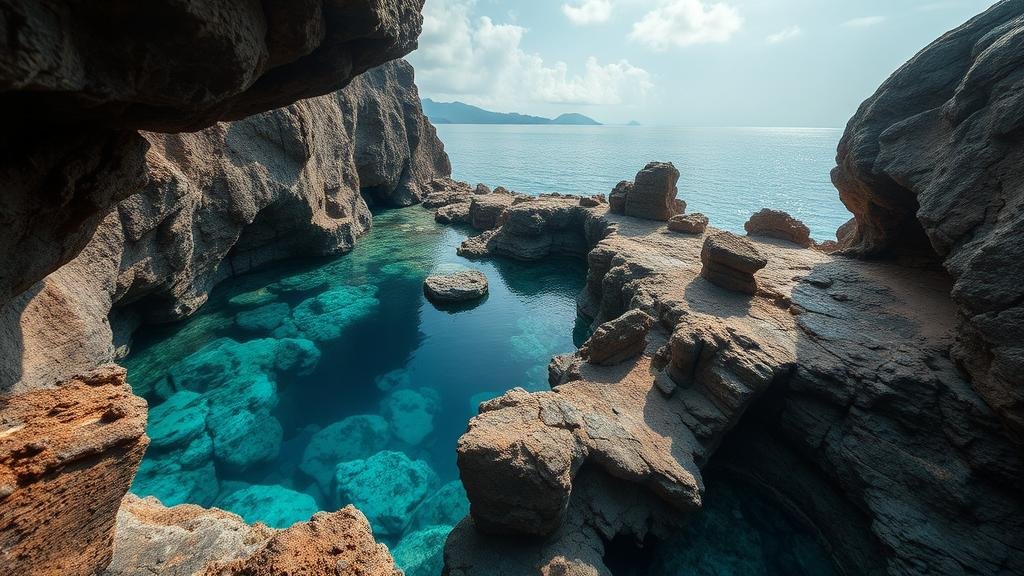Investigating the mysterious blue hole formations in the South China Sea, which are rumored to contain unique species yet undiscovered.
Investigating the Mysterious Blue Hole Formations in the South China Sea
The South China Sea, a region rich in biodiversity and marine mysteries, is home to numerous enigmatic geological structures known as blue holes. These underwater sinkholes are not only captivating but are rumored to harbor unique species yet undiscovered by science. This article delves into the significance of these blue holes, the scientific efforts to explore them, and the potential findings that could reshape our understanding of marine ecosystems.
Understanding Blue Holes
Blue holes are submerged caverns or sinkholes that can reach significant depths, usually formed from the dissolution of limestone or coral reefs. exhibit distinct blue coloration due to light absorption and reflection, appearing as striking ovals or circular shapes in satellite images. The South China Sea boasts several blue holes, with notable examples including the “Dragon Hole†located in the Paracel Islands, which has been measured at a depth of over 300 meters.
Unique Biodiversity
One of the most compelling aspects of blue holes is their potential to host unique marine species. The enclosed nature and varying salinity and temperature gradients create isolated environments where species can evolve independently. Scientists believe some of the microorganisms found in these ecosystems might have applications in biotechnology and medicine.
- Deep-sea corals which may contain unique pigments used in pharmaceuticals.
- Microbial life potentially offering insights into extremophiles, organisms that thrive in extreme conditions.
For example, research conducted in 2018 by a team at the Ocean University of China revealed a previously unknown microbial genus found in the Dragon Hole, which exhibited unique metabolic capabilities. This discovery hints at the opportunities for advancements in genetics and environmental science.
The Role of Researchers
Scientific exploration of these underwater phenomena has gained momentum. Numerous oceanographic expeditions aim to document the biodiversity within blue holes and assess their ecological health. In 2020, an expedition led by the Chinese Academy of Sciences utilized advanced remotely operated vehicles (ROVs) and autonomous underwater vehicles (AUVs) to map the depths and capture video footage of the marine life.
The findings from these explorations contribute significantly to our understanding of marine ecosystems. For example, researchers have identified over 200 different species within a single blue hole, ranging from various fish species to unique invertebrates. Also, studies suggest that these areas may act as biodiversity hotspots, harboring a wealth of life that supports surrounding marine environments.
Environmental Concerns
While the exploration of blue holes can lead to groundbreaking discoveries, it is essential to address the environmental concerns tied to marine research. Unregulated tourism and resource extraction pose substantial threats to these sensitive ecosystems. Overfishing and pollution can disrupt the delicate balance, risking the extinction of endemic species still unknown to science.
- Proactive conservation measures are needed to protect these blue holes.
- Establishing marine protected areas will help mitigate human impact.
Awareness campaigns and collaboration between governments, NGOs, and local communities are vital for fostering responsible exploration practices. The establishment of regulations to limit activities such as fishing and tourism near these formations can safeguard their biodiversity.
Conclusion and Future Directions
The blue holes of the South China Sea represent a frontier in marine biology and ecological research. As investigations continue, there lies the potential for significant discoveries that could not only deepen our understanding of marine life but also provide critical insights into issues such as climate change and biodiversity conservation. For aspiring researchers and enthusiasts, increased awareness and responsible exploration are essential for determining the fate of these remarkable underwater ecosystems.
In summary, further studies in the mysterious blue holes could yield breakthroughs in science while simultaneously highlighting the urgent need for environmental stewardship in one of the worlds most biodiverse marine areas.



